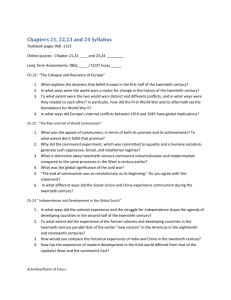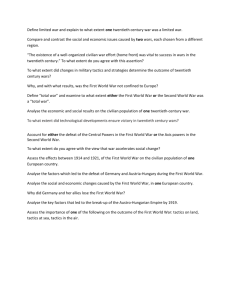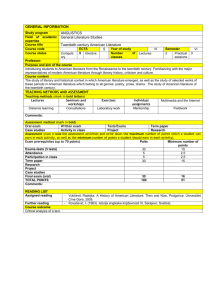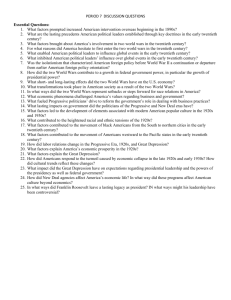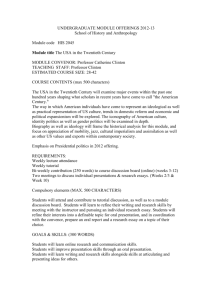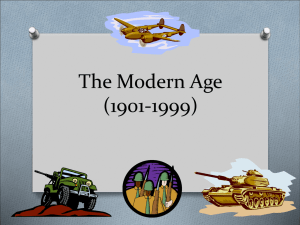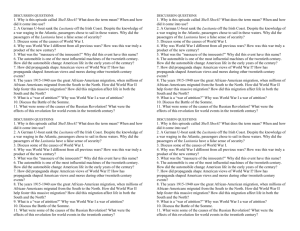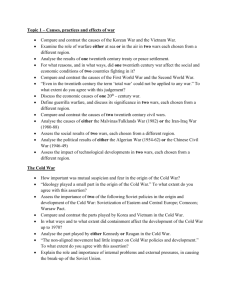AP EURO IDENTIFICATIONS CHAPTER 22: SOCIAL, CULTURAL
advertisement
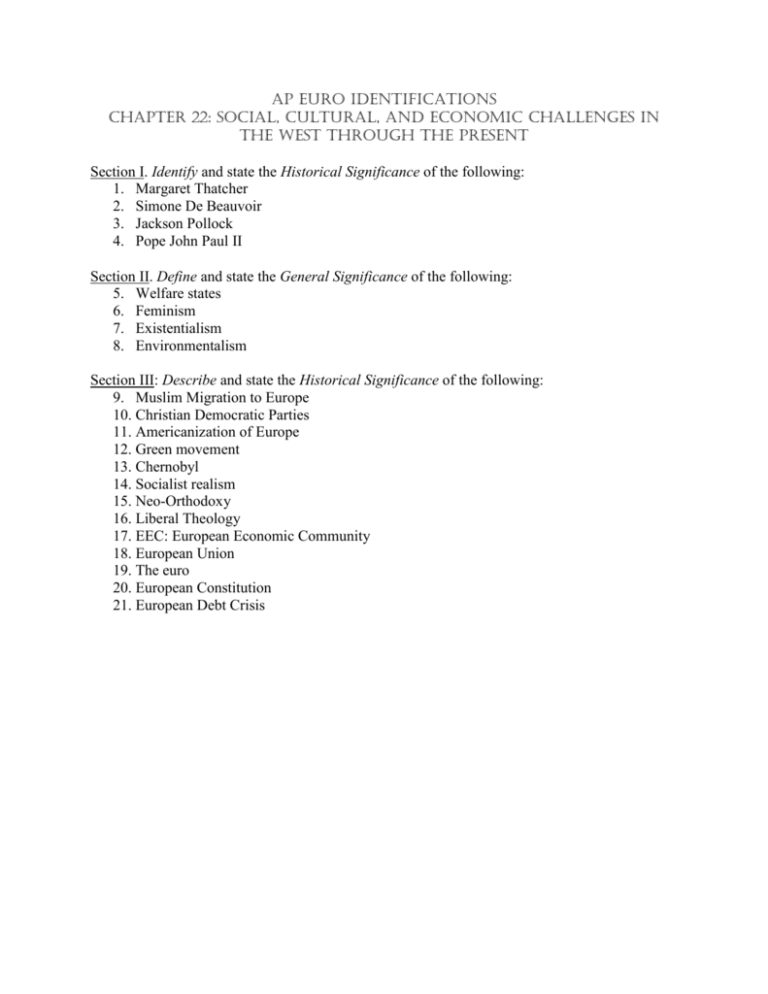
AP EURO IDENTIFICATIONS CHAPTER 22: SOCIAL, CULTURAL, AND ECONOMIC CHALLENGES IN THE WEST THROUGH THE PRESENT Section I. Identify and state the Historical Significance of the following: 1. Margaret Thatcher 2. Simone De Beauvoir 3. Jackson Pollock 4. Pope John Paul II Section II. Define and state the General Significance of the following: 5. Welfare states 6. Feminism 7. Existentialism 8. Environmentalism Section III: Describe and state the Historical Significance of the following: 9. Muslim Migration to Europe 10. Christian Democratic Parties 11. Americanization of Europe 12. Green movement 13. Chernobyl 14. Socialist realism 15. Neo-Orthodoxy 16. Liberal Theology 17. EEC: European Economic Community 18. European Union 19. The euro 20. European Constitution 21. European Debt Crisis CHAPTER 22 – SOCIAL, CULTURAL, AND ECONOMIC CHALLENGES IN THE WEST THROUGH THE PRESENT CHAPTER SUMMARY This chapter discusses the political, spiritual, and technological forces that shaped and reshaped much of the social experience of twentieth century Europe before and after World War II. In addition, it focuses on the intellectual life of Europe during the twentieth century and assesses the political and social climate in the early twenty-first century. The chapter begins by discussing the movement of peoples during and after World War II. The displacement of 46 million people in Central and Eastern Europe as well as in the Soviet Union resulted in border changes and internal migration to Western Europe. Between 1945 and 1960, about half a million Europeans left the continent, often to be replaced by non-European immigrants who entered as a result of the decolonization of European empires. French and British colonials came as “guest workers” to fill the labor needs of the growing European economies. The influx from Africa, Asia, and the Middle East became by the end of the twentieth century a source of racial and cultural antagonism that has spawned right-wing resentment and confrontation. Given special note in the chapter is the rising migration of Muslims into Europe and the attending tensions. Also given particular attention are the causes and consequences of the decline in the European birthrate over the course of the second half of the twentieth century. The chapter then discusses the establishment of the Welfare State in Western Europe during the 1950s and the economic implications of such social legislation at the end of the twentieth century. It then moves on to the changing roles of women in the work force and the development of feminism. Since World War II, European feminism has set a new agenda of political and social equality expounded in Simone de Beauvoir’s The Second Sex. There have been notable changes in the work patterns and social expectations of women. In all social ranks, women have begun to assert larger economic and wider political roles. The number of married women in the work force has sharply risen. Marriage remains a standard association of both men and women, but the birth rate has fallen or stabilized in many industrialized countries. The twentieth century has seen unparalleled changes in the pursuit and diffusion of knowledge. The technology of radio, television, and computers caused a communications revolution, fueled, as well, by the explosion of printed matter. The sheer quantity of information now available has in itself contributed to the fragmentation of public opinion and intellectual life. At the same time, a growing number of Europeans have received a university education, including women and people from many socio-economic backgrounds. The university became for the first time since the Reformation the center of intellectual life and its major new developments. Perhaps the single intellectual movement most characteristic of the mood of twentieth-century European culture is existentialism. Typically, the existentialists have all been influenced by the revolt against reason, which began in the nineteenth century. Rather than understanding human beings in the light of reason, the existentialists have argued, they must be examined in extreme situations. For these experiences, in which human nature is laid bare, show that people must formulate their own ethical values, rather than find them in traditional religion or rational philosophy. The anguished vision of the existentialists reflected the extreme conditions in an era of world wars. With the coming of prosperity to Europe in the 1960s, existentialist thought lost much of its popularity. The major existential writers include the Germans Martin Heidegger and Karl Jaspers, the Frenchmen Albert Camus and Jean-Paul Sartre, and the Dane Søren Kierkegaard. After a brief survey of art since World War II, the text turns its attention to the Christian heritage. Christianity underwent a theological revival after World War I. Churches have raised critical questions about colonialism, nuclear weapons, human rights, and other major issues. Many religious thinkers (especially Karl Barth) reemphasized the transcendence of God and the dependence of humankind upon the divine. This neo-orthodoxy rejected the nineteenth century’s optimism in man’s near divine nature. The chapter continues with an assessment of the impact of calculating machines and computers on society. By the end of the twentieth century, Europe had entered a new age of technological revolution through the computer and health advances in medical care. The chapter then turns to an assessment of economic cooperation and the unity of the European nations brought about by the formation of the European Union. However, the Union does not exist without discord. The future health of the Union will depend on the member states’ abilities to negotiate complex debates regarding social policies, the future of their economies, and what role the state should play in economic affairs. The chapter then examines three events in 2008 that may lead to a lessening of tensions between the United States and Europe and a new direction for Europe and the world. The first was the Russian invasion of Georgia discussed in Chapter 29. The second was the election of Barack Obama. The third was the beginning of a world financial crisis. The crisis and its fallout will dominate American and European affairs for many years to come. The chapter concludes with a discussion of the ongoing European debt crisis and its implications for further progress towards European economic and political union. OUTLINE I. The Twentieth-Century Movement of People A. Displacement Through War B. External and Internal Migration C. The New Muslim Population D. European Population Trends II. Toward a Welfare State Society A. Christian Democratic Parties B. The Creation of Welfare States C. Resistance to the Expansion of the Welfare State III. New Patterns in Work and Expectations of Women A. Feminism B. More Married Women in the Work Force C. New Work Patterns D. Women in the New Eastern Europe IV. Transformations in Knowledge and Culture A. Communism and Western Europe B. Existentialism C. Expansion of the University Population and Student Rebellion D. The Americanization of Europe E. A Consumer Society F. Environmentalism V. Art Since World War II A. Cultural Divisions and the Cold War VI. The Christian Heritage A. Neo-Orthodoxy B. Liberal Theology C. Roman Catholic Reform VII. Late-Twentieth-Century Technology: The Arrival of the Computer A. The Demand for Calculating Machines B. Early Computer Technology C. The Development of Desktop Computers VIII. The Challenges of European Unification A. Postwar Cooperation B. The European Economic Community C. The European Union D. Discord over the Union IX. New American Leadership and Financial Crisis. A. European Debt Crisis X. In Perspective LEARNING OBJECTIVES 1. How has migration changed the face of Europe? 2. What effect did the Great Depression and World War II have on the way Europeans viewed the role of government in social and economic life? 3. How did the status of women in business, politics, and the professions change in Europe in the second half of the twentieth century? 4. How was cultural and intellectual life transformed in Europe during the twentieth century? 5. How did the Cold War shape Western art in the second half of the twentieth century? 6. How has the Christian heritage of the West been affected by events of the twentieth century? 7. What impact has the computer had on twentieth-century society? 8. What led to Western European unification following World War II? 9. Was the year 2008 a turning point in the relationship between the United States and Europe? DISCUSSION QUESTIONS 1. How did migration affect twentieth-century European social life? What internal and external forces led to migration? 2. In what specific ways was Europe Americanized in the second half of the twentieth century? How do you explain the trend toward a consumer society? 3. How has Islamic migration into Europe affected social tensions on the Continent? How did the migration come about? What are incidents occur- ring in Europe that have raised resentment within the Islamic world? 4. How did women’s social and economic roles change in the second half of the twentieth century? What changes and problems have women faced since the fall of communism in Eastern Europe? 5. How did the pursuit and diffusion of knowledge change in the twentieth century? What have been the effects of the communications revolutions? Has Western intellectual life become more unified or less so? Why? 6. What were the technological steps in the emergence of the computer? What changes will computers bring in the next decade? 7. What were the major steps in the emergence of the European Union? Why is the Union now facing crisis?
